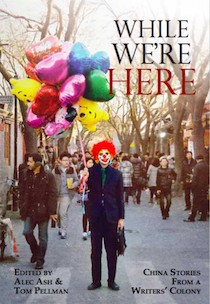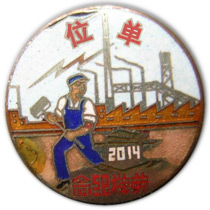Portrait of a Beijinger: Raise the Red Flag (video)
A classic car enthusiast leaves the civil service in his rear-view mirror – by Tom Fearon
In this short documentary series, Tom Fearon and Abel Blanco profile an ordinary Beijinger with an extraordinary story. We’re proud to present the third episode in the series, along with Tom’s story of meeting its protagonist Luo Wenyou. The video is on Youku for streamers in China, and on Vimeo as embedded below. Watch the previous two episodes in the series: Call of Duty and Beneath the Makeup
Luo Wenyou felt his comrades’ eyes burn into him. Fresh out of high school, the soft-spoken teenager tried to look busy on his first day at the Chengde public security bureau. His father’s connections had given him an “iron rice bowl”, a job for life in China’s civil service. It was a safe port in the chaos of the Cultural Revolution, but Luo felt awkward in his oversized uniform. When the police chief promised Luo he’d be Hebei’s top cop within a decade, it did little to ease the 18-year-old’s nerves.
After a bumpy start, Luo began to settle into his routine. He even seemed to take the swagger of officialdom in his stride. By 21, he had bought his first car: a powder blue FSO Warszawa. He polished its chrome grille and wheels twice weekly. When the radio signal was strong, he felt like he was chauffeuring a PLA band. The only rival for Luo’s affection was his passenger on weekend trips to the countryside, his girlfriend Yang Yijun.
The Polish sedan’s boxy, bug-eyed design resembled an early model Hongqi – the “red flag”, China’s revolutionary roadster powered by a V8, 200 horsepower and the pride of a nation. The Hongqi used to be the car of choice for officials in China, before the Audi A6 took that privilege. But it is still used at official functions, and Xi Jinping rode in one at the military parade to celebrate the 70th anniversary of Japan’s wartime surrender on September 3rd.

There weren’t any traffic jams back then. The only nuisances were swarms of bicycles in the city and giant potholes outside of it. For Luo, getting behind the wheel required dressing the part, even if the bourgeois sight of a young motorist in a suit and tie drew suspicious stares. The stares didn’t bother him, though. He felt free and in control each time wrapped his fingers around the thin, wood-grained steering wheel.
As Luo’s passion for cars grew, his interest in work declined. He explored ways to combine cars with his career. By the time he was 24, China’s era of reform and opening-up was in full swing and Luo began planning his new direction. He started by running a transportation fleet for a state-owned company. By the 1980s, when he might have been among Hebei’s top brass, he was in charge of a car repair company and a go-kart track.
Like any collection, his passion for classic cars began in earnest. But unlike coins or stamps, it wasn’t easy to find space for dozens of vehicles, ranging from Empress Dowager Cixi’s imperial buggy to World War II jeeps. Transportation was another headache. Apart from the odd rally every few years, classic cars aren’t legal on the streets of China, irrespective of their modernization. Deliveries had to be made in trucks or under the cover of night.
Buying cars could be difficult, too. When Luo spotted a Dongfanghong BJ760 sedan, he knew he had to have it. “You can’t force your way as a buyer,” he explains. Instead he showed up at the owner’s workplace each day to do odd jobs. He shoveled coal into the furnace, mopped the floors and filled the thermos with boiling water each morning to curry favor. A few years later, the owner eventually agreed to sell Luo the car, one of just 238.
In 2009, Luo opened his museum to share his collection of more than 200 classic cars with the public. Located in Huairou district, near a film studio that rents his cars for period TV shows and movies, the building’s chic design gives it the appearance of a museum for contemporary art rather than classic cars.
“We get a wide range of visitors, including many elderly people,” Luo says. “When they see cars they once rode in or drove, they feel a sense of nostalgia that makes them young again.”
Had he stayed the course in the civil service, Luo might have ranked somewhere between former Chongqing police chief Wang Lijun and ex-security tsar Zhou Yongkang, he says – both now serving lengthy sentences after being swept up in Xi Jinping’s purge.
Luo is coy when the topic of conversation turns to politics. His museum has benefited from government support, displayed by photos with former president Jiang Zemin and other members of his inner circle, including Jia Qinglin and Liu Qi. There is even a framed calligraphy scroll by Jiang’s deputy, Li Lanqing, extolling the pride of China’s national car culture.
For his part, Luo’s museum revs up Party prestige. Parents take photos of their children saluting next to Hongqi cars, eerily positioned as if in an automotive plenum. Cars used to inspect military parades or to chauffer visiting world leaders are surrounded by Chinese flags, while Luo’s boyish black-and-white portrait is displayed with his handwritten caption: “Chinese dream, my dream.”
Beside the portrait is another photo, a well-dressed couple posing with the blue sedan on a mountain road. Luo still has the same wide smile and neat mop of dark hair, but these days he’s more comfortable in his mechanic clothes and cloth shoes. 40 years later Yang Yijun is still at his side, supporting a hobby that she thinks might have reached its limit.
“Take a look around,” she says, eyes rolling around the 3,000-square-meter museum. “There isn’t any room for more cars."


•
Text, interviewing and subtitles by Tom Fearon; cinematography and photos by Abel Blanco
Tom Fearon is a writer and editor who has lived in China since 2009. He worked in Chinese state media for many years, and was a print journalist in Cambodia and Australia
Abel Blanco is a videographer based in Beijing who formerly worked in broadcast media in Spain. You can see some of his other short films here. Follow him on Instagram @abelblanco


















